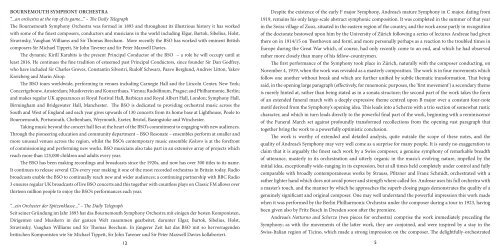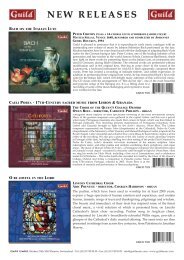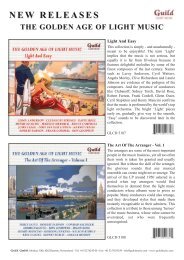MARC ANDREAE VOLKMAR ANDREAE
MARC ANDREAE VOLKMAR ANDREAE
MARC ANDREAE VOLKMAR ANDREAE
Sie wollen auch ein ePaper? Erhöhen Sie die Reichweite Ihrer Titel.
YUMPU macht aus Druck-PDFs automatisch weboptimierte ePaper, die Google liebt.
BOURNEMOUTH SYMPHONY ORCHESTRA<br />
“...an orchestra at the top of its game...” – The Daily Telegraph<br />
The Bournemouth Symphony Orchestra was formed in 1893 and throughout its illustrious history it has worked<br />
with some of the finest composers, conductors and musicians in the world including Elgar, Bartok, Sibelius, Holst,<br />
Stravinsky, Vaughan Williams and Sir Thomas Beecham. More recently the BSO has worked with eminent British<br />
composers Sir Michael Tippett, Sir John Tavener and Sir Peter Maxwell Davies.<br />
The dynamic Kirill Karabits is the present Principal Conductor of the BSO – a role he will occupy until at<br />
least 2016. He continues the fine tradition of esteemed past Principal Conductors, since founder Sir Dan Godfrey,<br />
who have included Sir Charles Groves, Constantin Silvestri, Rudolf Schwarz, Paavo Berglund, Andrew Litton, Yakov<br />
Kreizberg and Marin Alsop.<br />
The BSO tours worldwide, performing in venues including Carnegie Hall and the Lincoln Center, New York;<br />
Concertgebouw, Amsterdam; Musikverein and Konzerthaus, Vienna; Rudolfinum, Prague; and Philharmonie, Berlin;<br />
and makes regular UK appearances at Royal Festival Hall, Barbican and Royal Albert Hall, London; Symphony Hall,<br />
Birmingham and Bridgewater Hall, Manchester. The BSO is dedicated to providing orchestral music across the<br />
South and West of England and each year gives upwards of 130 concerts from its home base at Lighthouse, Poole to<br />
Bournemouth, Portsmouth, Cheltenham, Weymouth, Exeter, Bristol, Basingstoke and Winchester.<br />
Taking music beyond the concert hall lies at the heart of the BSO’s commitment to engaging with new audiences.<br />
Through the pioneering education and community department – BSO Resonate – ensembles perform at smaller and<br />
more unusual venues across the region, whilst the BSO’s contemporary music ensemble Kokoro is at the forefront<br />
of commissioning and performing new works. BSO musicians also take part in an extensive array of projects which<br />
reach more than 125,000 children and adults every year.<br />
The BSO has been making recordings and broadcasts since the 1920s, and now has over 300 titles to its name.<br />
It continues to release several CDs every year making it one of the most recorded orchestras in Britain today. Radio<br />
broadcasts enable the BSO to continually reach new and wider audiences; a continuing partnership with BBC Radio<br />
3 ensures regular UK broadcasts of live BSO concerts and this together with countless plays on Classic FM allows over<br />
thirteen million people to enjoy the BSO’s performances each year.<br />
“...ein Orchester der Spitzenklasse...” – The Daily Telegraph<br />
Seit seiner Gründung im Jahr 1893 hat das Bournemouth Symphony Orchestra mit einigen der besten Komponisten,<br />
Dirigenten und Musikern in der ganzen Welt zusammen gearbeitet, darunter Elgar, Bartok, Sibelius, Holst,<br />
Stravinsky, Vaughan Williams und Sir Thomas Beecham. In jüngerer Zeit hat das BSO mit so hervorragenden<br />
britischen Komponisten wie Sir Michael Tippett, Sir John Tavener und Sir Peter Maxwell Davies kollaboriert.<br />
12<br />
Despite the existence of the early F major Symphony, Andreae’s mature Symphony in C major, dating from<br />
1919, remains his only large-scale abstract symphonic composition. It was completed in the summer of that year<br />
in the Swiss village of Zuoz, situated in the eastern region of the country, and the work arose partly in recognition<br />
of the doctorate bestowed upon him by the University of Zürich following a series of lectures Andreae had given<br />
there on in 1914/15 on ‘Beethoven and form’, and more personally perhaps as a reaction to the troubled times in<br />
Europe during the Great War which, of course, had only recently come to an end, and which he had observed<br />
rather more closely than many of his fellow-countrymen.<br />
The first performance of the Symphony took place in Zürich, naturally with the composer conducting, on<br />
November 4, 1919, when the work was revealed as a masterly composition. The work is in four movements which<br />
follow one another without break and which are further unified by subtle thematic transformation. That being<br />
said, in the opening large paragraph (effectively, for mnemonic purposes, the ‘first movement’) a secondary theme<br />
is merely hinted at, rather than being stated as in a sonata structure; the second part of the work takes the form<br />
of an extended funeral march with a deeply expressive theme centred upon B major over a constant four-note<br />
motif derived from the Symphony’s opening idea. This leads into a Scherzo with a trio section of somewhat rustic<br />
character, and which in turn leads directly to the powerful final part of the work, beginning with a reminiscence<br />
of the Funeral March set against profoundly transformed recollections from the opening vast paragraph that<br />
together bring the work to a powerfully optimistic conclusion.<br />
The work is worthy of extended and detailed analysis, quite outside the scope of these notes, and the<br />
quality of Andreae’s Symphony may very well come as a surprise for many people. It is surely no exaggeration to<br />
claim that it is arguably the finest such work by a Swiss composer, a genuine symphony of remarkable breadth<br />
of utterance, masterly in its orchestration and utterly organic in the music’s evolving nature, impelled by the<br />
initial idea, exceptionally wide-ranging in its expression, but at all times held completely under control and fully<br />
comparable with broadly contemporaneous works by Strauss, Pfitzner and Franz Schmidt, orchestrated with a<br />
rather lighter hand which does not avoid power and strength where called for. Andreae uses his full orchestra with<br />
a master’s touch, and the manner by which he approaches the superb closing pages demonstrates the quality of a<br />
genuinely significant and original composer. One may well understand the powerful impression this work made<br />
when it was performed by the Berlin Philharmonic Orchestra under the composer during a tour in 1923, having<br />
been given also by Fritz Busch in Dresden soon after the premiere.<br />
Andreae’s Notturno and Scherzo (two pieces for orchestra) comprise the work immediately preceding the<br />
Symphony; as with the movements of the latter work, they are conjoined, and were inspired by a stay in the<br />
Swiss-Italian region of Ticino, which made a strong impression on the composer. The delightfully-orchestrated<br />
5
















